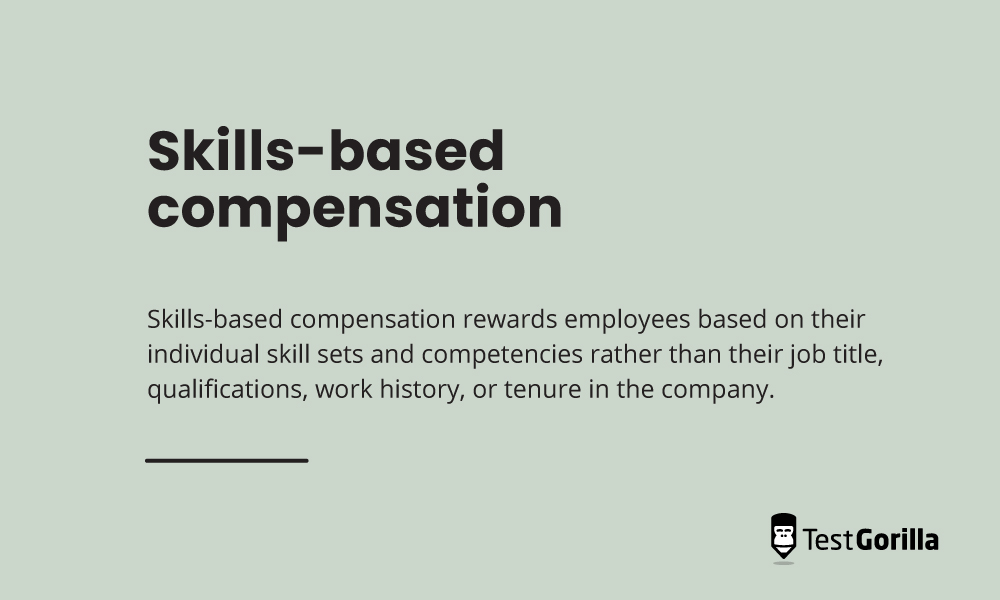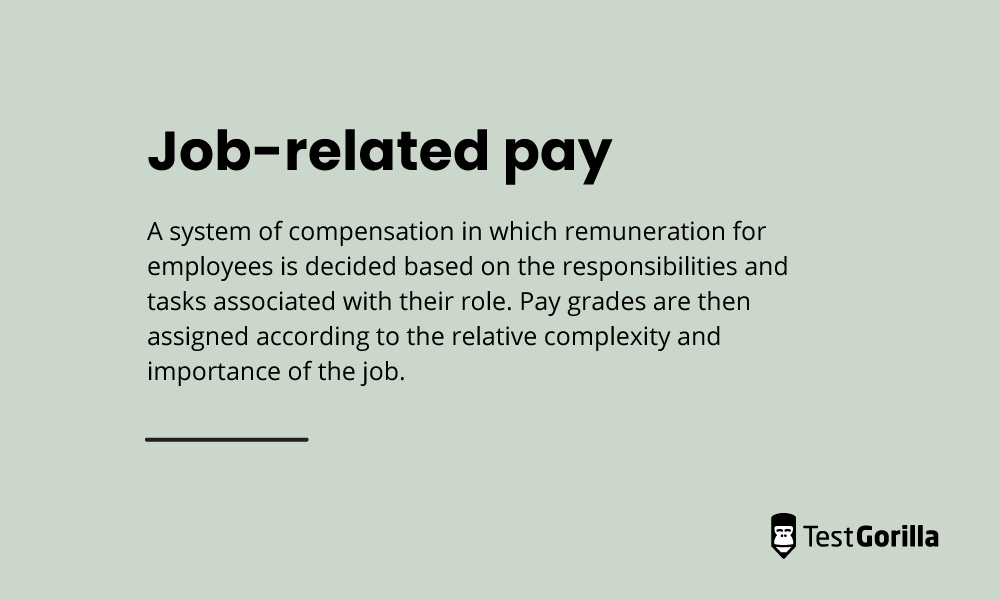Skills-based compensation: A fairer way to pay
In a bid to compete in the war for talent, more companies are removing degree requirements from job descriptions, adopting skills-based hiring, and implementing pay transparency measures.
According to our 2022 State of Skills-based Hiring report, 76% of employers across the US, UK, Australia, Canada, and New Zealand are using competency-based recruitment to build more diverse, resilient, happier teams.¹
This means that traditional compensation models based on qualifications, experience, or tenure may no longer be fit for purpose.
But how do you fairly compensate people when these factors are removed from the equation?
Enter skills-based compensation, which rewards people based on the skills they bring to or acquire in the role. It can also give your company a competitive advantage, make you more attractive to candidates, and help create a fairer work environment that makes for happier employees.
Applying skill based pay isn’t always straightforward, though. For example, how do you ensure it’s implemented in a way that’s equitable and sustainable?
We’ll look at what skills-based compensation is, the benefits and challenges of applying it, and six strategies to help you do just that.
Table of contents
- What is skills-based compensation?
- How does skill based pay compare to other compensation models?
- Why should you adopt skill based pay rather than other models?
- What are the challenges of paying based on skills?
- 6 steps to apply skills-based compensation in your organization
- Skills-based compensation: A fairer, more transparent way to pay
- Sources
What is skills-based compensation?
Skills-based compensation rewards employees based on their individual skill sets and competencies rather than their job title, qualifications, work history, or tenure in the company.
This model is designed to create a culture of continuous learning and encourage people to reskill and upskill. It does this by making sure they’re rewarded for the range and depth of their abilities and experience.
For example, an employee who is proficient in computer programming, data analysis, and project management may earn a higher salary than an employee who only has one of these skills. Similarly, a salesperson who’s highly skilled in social selling and using customer relationship management software can earn more than another candidate without these competencies.
How does skill based pay compare to other compensation models?
There are three primary objectives that must be balanced when creating a any employee pay system.
Equity: Employees should receive fair compensation for their work. There shouldn't be massive disparities between the amount paid to individuals in similar roles.
Efficiency: There should be a clear link between an employee's pay and their output, performance, achievements, and skills.
Recruitment: The compensation offered should provide sufficient incentive for candidate's that the company is trying to recruit.
Traditionally, these objectives have been accommodated through a job-based pay model. In this system of compensation, remuneration for an employee is decided based on the responsibilities and tasks associated with the role. Pay grades are then assigned according to the relative complexity and importance of the job.
The main drawback of job-related pay is the subjectivity and rigidity of the system. First, it's extremely difficult to evaluate the value or difficulty of a job. Second, employees who work in similar roles but vary significantly in terms of their competency and performance levels will still be compensated identically within the model, which can be a significant demotivator.
Many employers have looked to address these concerns by adding a performance-related incentive to the base pay rate for employees. In this model employees' performance is appraised on a periodic basis to determine whether their work is meeting or exceeding expected levels for their job title. Those who fall into the latter group are rewarded with bonuses, pay raises, and in some cases promotions.
In some cases, financial incentives are linked to the achievement of overall team goals. For example, a team of retail workers might be awarded bonuses for selling a certain number of warranties over a defined period. This is known as team-based pay.
However, any additional knowledge, certifications, or training employees have gained over the appraisal period are ignored in a pay-for-peformance model.
The best insights on HR and recruitment, delivered to your inbox.
Biweekly updates. No spam. Unsubscribe any time.
Why should you adopt skill based pay rather than other models?
Skills-based compensation helps you build a more skilled, motivated, and productive workforce, while also being a fairer way to reward people.
Let’s take a look at the benefits in more detail.
1. It gives you a competitive edge
Compensating your people for their abilities and experience motivates them to gain a wider range of skills.
This gives you a competitive edge because team members will be motivated to gain the necessary skills and competencies to meet the growing – and changing – needs of your organization, their roles, and the market.
Additionally, it helps individuals become more versatile and able to move upwards and sideways into a variety of roles. It’s great for organizations looking to build agile, cross-functional teams.
2. It makes you more attractive to candidates
Skills-based compensation makes your organization more attractive to job seekers because it demonstrates your commitment to fairness and employee development. It also shows you value your people’s skills and are willing to invest in their development, all of which plays well with Gen Z, among other profiles.
In fact, 76% of employees say they’re more likely to stay with a company that offers continuous training.
Additionally, candidates skilled by alternative routes (STARs) may value organizations that recognize and reward their expertise, rather than prioritizing their education and background. That means applying skills-based compensation puts you in a better position to compete for global talent in a changing world.
3. It helps put the right people in the right roles
Role- or tenure-based compensation doesn’t always guarantee that the best people are in the right positions. In some industries – like education and healthcare – pay may increase automatically based on seniority, regardless of whether someone has acquired new skills or is a good fit for that role.
On top of that, in many industries workers can only access higher pay by moving to a managerial role – even if it’s not for them. This means you might have people in leadership positions who aren’t happy in the role or well-suited to managing people.
Skills-based compensation ensures there are people with top managerial skills in managerial positions, which helps create a more capable team.
4. It makes for happier, more engaged team members
Skills-based compensation motivates your people to continuously develop new skills and improve their existing ones. This means they’ll consistently keep their skills up-to-date and add value to your company.
Finally, identifying pay gaps and addressing pay equity issues help you enhance employee buy-in and build trust in the new pay structure. Additionally, when your teams feel compensation decisions are fair and transparent, they’re more likely to be motivated and engaged in their work.
5. It contributes to a fairer work environment
When implemented correctly, skills-based pay helps create a fairer work environment. That’s because it rewards people based on their specific skills and knowledge, rather than factors like race, ethnicity, gender, connections, or seniority.
Additionally, skills-based compensation is more transparent than other pay models. This is because the criteria for determining pay or bonuses are based on specific skills and performance metrics.
Not only is transparency about pay expected by Gen Z employees, but it’s also an important step toward closing pay gaps. That’s because it helps ensure pay decisions are objective and based on merit, rather than subject to bias or favoritism.
What are the challenges of paying based on skills?
While there are many benefits to skills-based compensation, it can also be complex to implement. That’s because you need to identify and measure specific skills and competencies. Also, to establish a fair, consistent, and scalable method for determining pay based on those skills.
To do this successfully, you need a tool to help you assess competencies. You also need to be constantly assessing your people’s hard, soft, and transferable skills, some of which are easier to evaluate than others.
This can result in higher administrative expenses and be challenging for young companies that lack the proper tools or resources. However, these costs are usually offset by leaner staffing and higher performance.
Some other challenges include:
Resistance to change: Some individuals might be wary of the new system because they feel it’s unfair or it undervalues their experience and seniority.
Potential for misunderstandings: If the criteria for skills assessment and pay determination are not clearly communicated to employees, it may lead to confusion and distrust between your people.
Risk of inequity: Ironically, if skills-based compensation isn’t implemented fairly and consistently, it might result in pay disparities and low morale among team members.
Let’s take a look at how you can avoid these risks and successfully implement skills-based pay.
6 steps to apply skills-based compensation in your organization
Despite its challenges, skills-based compensation is an effective way to reward and retain high-performing employees, improve motivation and engagement, and build a more skilled, adaptable workforce.
Here are six best practices for applying this model to your organization fairly and effectively.
1. Find out where pay gaps exist
If you implement skills-based compensation without first identifying pay gaps in your organization, you could unintentionally end up widening them.
For example, if certain groups of employees have historically been paid less than others, they may not have had the resources to access learning and development (L&D) opportunities. This may make it harder for them to demonstrate the skills required for higher pay under a skills-based compensation system.
Some of the widest pay gaps are between men and women and between White employees and their BIPOC (Black, Indigenous, People of Color) peers.
According to data from the Pew Research Center, women earned an average of 82% of what men earned for the same job. This means on average, for every $1 paid to a man, approximately $0.82 cents was paid to a woman in an equivalent role.
Black and Latina women are also paid significantly less than White women and White men. In the UK in 2022, the pay gap was around 8.3% – but wider for women of color.[2]
You might also discover pay disparities in your organization between workers with university degrees and STARs with similar skills. Implementing skills-based pay can help close that gap.
Remember: Identifying pay gaps helps you address issues of pay equity within your organization. Without this information, you may not be aware of gender pay gaps and other disparities in pay that exist based on factors such as ethnicity, race, religion, sexual orientation, disability, or education.
Addressing these disparities is important for promoting a fair and inclusive workplace, regardless of how you pay.
2. Rethink how you assess skills and qualifications
Implementing skill based pay requires you to first identify valuable skills and rethink how you value qualifications. For example, you need to know which certifications and competencies are equivalent to a degree before you can determine the pay of two individuals in the same position who have different qualifications.
Putting a value on skills also helps you determine which are most valuable to your organization and, therefore, eligible for higher compensation.
Rethinking your assessment procedures is the first step to establishing objective criteria for determining compensation, so you can ensure your process is consistent, equitable, and unbiased. Start by implementing skills-based hiring to level the playing field for all candidates, regardless of experience or qualifications.
As you overhaul your processes, be sure to communicate new findings and updates to your existing teams. By stressing the importance of certain skills and qualifications, you can incentivize them to seek out training and development opportunities before the new system is implemented.
3. Set compensation
There’s no one size fits all approach to setting skills-based compensation since it highly depends on your company structure, industry, and size. But overall, it requires a structured, data-driven process to guarantee transparency and equity.
Here are some general steps you can take to do just that:
Identify key skills: Conduct a skills-gap analysis to identify the skills your workforce currently lacks and those they need to achieve the organization’s strategic goals.
Pro tip: When you find out what knowledge is lacking in your organization, you can offer upskilling and reskilling opportunities, succession planning, and additional training to bridge the gap. Your findings also help you design salary bands and guide you in setting compensation based on career paths and job architecture.
Define skill levels: This involves breaking down each skill into different levels of proficiency or mastery, and establishing clear criteria for each level. In this step, you can also use objective measures like certifications, performance metrics, and assessments to determine each person’s skill level.
Establish compensation ranges: Based on the defined skill levels, you can establish compensation ranges for each skill. This involves determining the minimum, midpoint, and maximum pay for each level of proficiency or mastery.
At TestGorilla, we do this by breaking job functions into salary bands. Each band is correlated with a higher level of skill. For example, for a content writer, their next skill level may mean being able to produce high-quality content. For a content strategist, it might be having the skills to analyze the impact of their content and use that data to guide broader marketing strategies.
Monitor and adjust: It’s crucial to monitor the effectiveness of your skills-based pay model and ensure it’s bias-free and objective. To do this, hold regular reviews of compensation data, analyze trends and patterns, and make adjustments to compensation ranges or skill levels as necessary.
4. Be transparent about pay
Pay transparency involves openly sharing information about salaries and bonuses in your organization and with potential candidates. The aim is to increase fairness and equity across the board by ensuring everyone is paid equally based on what they bring to the role, rather than their gender, race, or other factors.
Being transparent about compensation is also a way for you to build trust with your team members, boost engagement and productivity, and create a better work environment.
When making any compensation decision, be open and honest with people. Let them know you’re available to answer any questions or concerns. Finally, communicate how different roles are compensated and what skills people can gain to improve their pay.
5. Use skills-based tests to continually assess skills
Consistently assessing existing employees’ skills is essential to making fair decisions about personnel and compensation, like promotions and pay rises.
Having up-to-date information about your people’s skills and knowledge also helps you empower them to do their best work. For example, if you notice a gap in your customer service representative’s technical skills, you can provide them with the courses and mentoring they need to bridge it before they fall behind.
Using skills-based tests lets you assess your people’s skills and make sure everyone is thriving in the right role. Skills-based tests can take many forms, including written tests, performance assessments, and simulations.
Here’s how:
Determine the skills you want to assess by role: For example, customer service, React Native, or Google Ads.
Administer the appropriate tests on a regular basis: For example, quarterly or semiannually.
Analyze the results: Identify areas where employees may need additional training or development. Use this information to inform compensation decisions and identify opportunities for career growth and advancement.
Provide employees with feedback on their test performance: Let them know their areas of strength and areas of growth.
Remember: Practice radical candor when giving feedback of any kind. This means telling the truth while leading with empathy and kindness. Because when you challenge people from a place of caring, you help them grow without hurting their morale.
6. Provide learning and development resources
If you’re paying based on skills, you also need to create opportunities for employees to upgrade them by offering free access to courses or creating L&D opportunities on the job. For example, shadowing a colleague or spending time in another department or on a shared project. You should also offer paid time off for learning to avoid penalizing or discouraging employees who may not be able to afford either the cost of training or the hit to their pay packet if they take time off to study.
To offer L&D opportunities:
Align learning objectives with overall business goals
Establish a budget that covers both the cost of training, paid time off, and any cover required for employees
Prioritize skills and roles for development based on skills gap assessments and business goals
Plan training based on priorities, learning styles, and learning environment (on-the-job or course-based)
Put L&D resources and tools in place
Deliver training
Gather feedback
Assess results and L&D KPIs
Iterate and repeat
Skills-based compensation: A fairer, more transparent way to pay
Skills-based compensation is a pay model that rewards people based on their skill set and competencies. Instead of their job title, seniority, education, or qualifications. Using real data about your employees’ skills also removes any possibility that they’ll be compensated less because of a bias against their ethnicity, sexual orientation, gender, neurodiversity, or disability.
This system uses data-backed, unbiased assessment methods to foster a culture of continuous learning and encourage people to build their knowledge and skills.
Skills-based pay also helps you create a more skilled, flexible, motivated, and productive team where everyone is fairly rewarded. Additionally, it makes your company more attractive to candidates and ensures the right people are in the right roles – at all levels.
But skills-based pay can be complex to implement. That’s because it requires you to identify and measure specific skills and establish an objective, consistent method for determining pay.
That’s why our top six tips to apply skills-based compensation in your company are:
Find out where pay gaps exist
Rethink how you assess skills and qualifications
Set compensation
Be transparent about how people are compensated
Use skills-based tests to continually assess skills
Offer learning and development resources
When you implement these best practices to build a fairer, future-proof compensation strategy, you’ll be well on your way to creating a more inclusive, diverse, and productive organization.
Want a fairer way to compensate diverse talent? Skills-based hiring paves the way for skills-based compensation and happier, more productive teams. Download the 2022 State of Skills-Based Hiring report to learn more
Sources
“Gender Pay Gap in the UK: 2022” Office for National Statistics. Accessed March 6, 2023.
You've scrolled this far
Why not try TestGorilla for free, and see what happens when you put skills first.


















